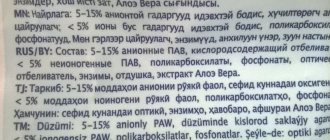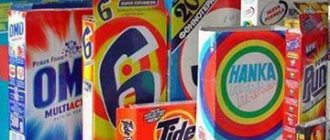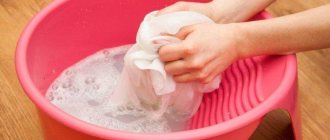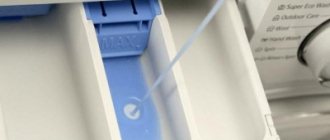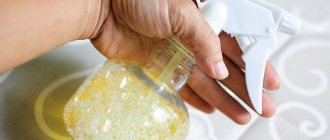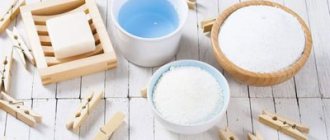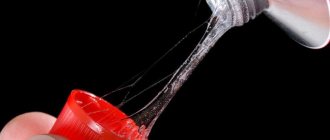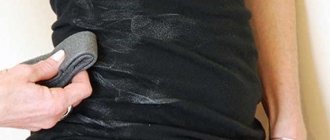How to remove powder stains?
Unpleasant stains that appear after washing can be removed using these cleaning options, choose at your discretion.
Method 1 - soap and vinegar
To restore cleanliness to your clothes and remove stains from washing powder, proceed as follows:
- Add laundry soap and a little vinegar to a bowl of warm water;
- Dip the item with stains into the resulting solution;
- Wash;
- Then take the item out and rinse several times.
Important! You can replace vinegar with baking soda. Before washing the item, dissolve the baking soda well, otherwise there will be no effect.
Method 2 - rinse aid
If powder stains appear on colored clothing, remove them as follows:
- Add fabric softener to the water;
- Rinse the item in this solution;
- Remove and rinse several times in clean water.
Method 3 - citric or oxalic acid
How to remove powder stains from clothes, you need:
- Add 1 tsp to a glass of hot water. citric or oxalic acid, mix well;
- Soak a cotton pad in the resulting solution;
- Wipe the contaminated areas of the item with a cotton pad;
- Rinse the item in clean water.
Method 4 - ammonia
Here's how to save light and white clothes from stains after washing:
- Add 1 tsp to 0.5 cups of water. ammonia, stir thoroughly;
- Soak cotton wool in the solution and treat the stained area;
- This procedure must be repeated several times.
Method 5 - hydrogen peroxide
Using hydrogen peroxide, you can quickly get rid of unpleasant stains after washing. Use it like this:
- Pour a third of a glass of water and add 1 tbsp. hydrogen peroxide;
- Mix well;
- Moisten the area of contamination with this solution;
- Leave for 10 minutes;
- Rinse the area to be cleaned with clean water.
Important! This cleaning option is suitable for white items; colored items may change their color.
Method 6 - detergent
If unpleasant stains appear on a poorly rinsed item, you can get rid of them like this:
- Place the item in the washing machine;
- Add detergent;
- Turn on double rinse mode;
- Remove and dry the item.
Important! If you wash by hand, then just place the item in a bowl of water for 30 minutes, do not forget to add detergent, then rinse well.
Why doesn't the powder foam in the washing machine?
This is a simple question. Washing powders for automatic washing are characterized by reduced foaming. This is done specifically so that washing machines do not deteriorate.
A large amount of foam confuses the automation. She incorrectly determines the water level. As a result, the heating element ends up in foam rather than in water. This may result in failure of the heating element, motor or electronic control unit.
Therefore, if the powder does not foam in the washing machine, it means that the washing is carried out according to all the rules.
How to avoid powder stains?
In order to no longer rack your brains over the question of how to remove powder stains from clothes after washing, we advise you to always use these recommendations:
- Use less powder, you may be adding too much so the powder doesn't wash out of the fabric.
- Do not overload the machine with things; it should be filled 2/3 full - less things improves rinsing.
- You can use double rinse mode.
- When washing by hand, rinse 2-3 times in warm water, then a couple of times in cold water.
- Instead of powder, use liquid detergent, gels or capsules - they quickly dissolve and are completely washed out.
- Things should be washed at temperatures above 30 degrees; only at this temperature will the powder granules penetrate the fabric to remove dirt and be thoroughly washed out of it. It is important to take into account the temperature of the item when washing; if it only requires delicate washing, then increasing the temperature is unacceptable.
- Choose your laundry detergent carefully, taking into account the type, structure and color of the fabric.
We hope that our tips helped you clean your item of stains after washing; be sure to use the recommendations for preventing the appearance of stains from detergent on fabric. Share tips on how to remove powder stains.
Minimal DIY repairs
A little more effort may be required to resolve the following issues:
1.Insufficient water pressure in the water pipe.
Solution: open any tap in the house and check the pressure. If it is weak, contact the utility service.
2. The water supply tap to the washing machine is closed or not fully unscrewed This small valve is installed at the junction of the water pipe and the water inlet hose into the washing machine. It could have been accidentally turned off by children or someone in the household turned off the water supply during the previous wash.
Solution: Turn the faucet to the open position.
Note! The fact that in your case the detergent was not washed out due to a poorly opened valve will be indicated by letting water flow into the washing unit for too long.
3. The fill valve filter is clogged. Unfortunately, tap water in many homes leaves much to be desired. The filling filter must be checked and cleaned periodically.
Solution: clean the mesh filter yourself.
Procedure:
- Disconnect the washing machine from the power supply and turn off the water supply.
- Unscrew the inlet hose (you can do it by hand). The hose is connected to the machine body at the rear at the top.
- Use pliers to grab the filter and pull it towards you.
- Rinse the filter under running water.
- Reinstall the filter.
- Screw on the hose.
4. The powder receptacle itself is clogged. The detergent drawer and the compartment in which it is installed must be cleaned periodically.
Solution : clean the powder receptacle again.
Procedure:
- Open the powder receptacle all the way.
- Press the lid of the air conditioner compartment with your finger (some models of washing machines have a special pointer) or simply pull the dispenser towards you and down a little, applying some force.
- Rinse and clean the dispenser.
- Clean the dispenser seat. Note! It is important to clean not only the sides and bottom, but also the top of the compartment. There are nozzles (holes) through which water is supplied.
Get rid of after washing
If, after washing, your favorite wardrobe item does not get the desired appearance, and is full of stains from powder, detergent, or whiteness, we recommend resorting to the following, no less original methods.
Method No. 1
If a small, barely noticeable stain appears on your favorite T-shirt, but its very appearance causes negative emotions, inspect the item and evaluate the color. Select a felt-tip pen or marker to match the color of the damaged item and carefully, pointwise, paint over the area affected by bleach. After light “makeup”, iron the affected area through a piece of cloth so that the excess dye is absorbed into it.
This is interesting: How to remove old, dried blood stains from fabric
Method No. 2
This method is more suitable for youth T-shirts, which, even at the production stage, are painted with all sorts of colors, deliberately creating stains and streaks.
To carry out this kind of resuscitation efficiently, you will need fabric paint.
In any sewing store you can find all kinds of colors and shades.
Natural fabrics lend themselves best to resuscitation in this way.
Method No. 3
This method is only slightly different from the previous one: to perform it correctly, you will have to go to a fabric store or a nail store and buy acrylic paint in tubes (which is important).
The viscous consistency of this type of paint will allow you to independently draw an applique, a pattern that will cover up, and maybe even organically play up the stain from the cleaning agent.
After the acrylic paint has completely dried on the product, you need to take a piece of cloth, cover the painted area and iron it. Once heated, the acrylic paint will firmly adhere to dense fabric and the pattern you apply yourself will delight you for a long time!
This method is suitable for all types of tissue, but it is best to carry out such resuscitation on rough tissues.
Method No. 4
Suitable for creative people who know how to embroider with thread or ribbons. It’s very beautiful when a bleach stain on a blouse is skillfully hidden under neat embroidery, especially considering that in recent years embroidery has remained quite a fashionable and stylish wardrobe detail. Perhaps a speck of bleach or Domestos will encourage you to create an incredibly fashionable masterpiece?
Method No. 5
This is the easiest and fastest method and is suitable for almost all types of fabrics that can be heated. In order to save your item, you just need to buy a patch at any hardware store. Then, at home, you smooth out the damaged item, put the patch you like on it and iron it thoroughly. Fast and convenient!
What to do for prevention?
Proper washing, preventing the appearance of smudges, occurs according to the following rules:
strict adherence to the temperature maximum indicated on the tag;- replacing crystalline powder with washing liquid or gel;
- intensive rinsing several times;
- "delicate wash;
- things in the typewriter are turned inside out;
- natural down jackets are washed with special balls;
- When cleaning manually, you should not wring out the clothes; you need to let the water drain on its own, hanging the product in a vertical position.
Drying a jacket is an important stage, during which you also need to follow the recommendations:
- warm jackets are dried exclusively horizontally to avoid drips and streaks;
- Do not allow the drying item to be exposed to sunlight;
- the procedure must be performed in a well-ventilated place (for example, on a balcony);
- Sometimes you need to turn the jacket over to dry evenly.
Proper drying
Simply removing the stains will not be enough. The product must be dried properly, otherwise they will appear again:
- do not press the item too hard, do not set the maximum number of revolutions;
- hang the jacket over the bathtub on hangers and let the remaining water drain;
- straighten to the correct shape;
- shake periodically so that the filler is distributed evenly;
- After drying, straighten the down or padding polyester with your hands in each cell.
Additional Information! To make the jacket dry faster, you can dry it with a vacuum cleaner. You need to put the smallest nozzle on it and turn it on at minimum power. Place the item horizontally and walk carefully with the device.
By following these simple recommendations, you can avoid stains on your clothes. If they do appear, the methods described will help you get rid of them quickly and inexpensively. You don't have to throw your favorite thing in the trash.
Rate this post
Clogged or broken machine drain
If there is a clog in the drain of the machine, the water from the drum will drain very slowly. Then undissolved powder and dirt can leave streaks on things.
To identify a blockage:
- Locate the small door at the bottom of the washing machine. There is a filter right behind it. If you have an older model, access to the filter will be through the back cover of the machine.
- Make sure the filter is not clogged with dirt, lint, or small objects. All this can interfere with the outflow of water.
After cleaning the filter, do a short wash to make sure any streaks are caused by accumulated debris.

